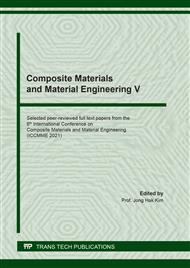p.53
p.59
p.65
p.73
p.79
p.85
p.91
p.98
p.107
Effect of Mono- and Bilayer Coating of Nanofibrillated Cellulose, its Modification, and Shellac on Properties of Molded Pulps
Abstract:
A molded pulp is increasingly used as eco-packaging, but it has poor water resistance. Therefore, surface coating is common to perform on pulp or paper packaging to overcome this shortcoming. In this study, the bagasse (BG) molded pulp sheets were mono-and bilayer coated with nanofibrillated cellulose (NFC), modified NFC (mNFC), and shellac (S) by using a spin coating technique. Surface morphology, surface wettability, water absorption, and mechanical properties of the coated sheet samples were evaluated and compared to the uncoated sample. It was found that mNFC could effectively provide an even and complete coverage coating layer on the BG-based sheet (BG/mNFC), thanks to the partially substituted ester groups. On the contrary, NFC could not be coated evenly on the BG-based sheet surface (BG/NFC) due to its tendency towards agglomeration. The homogeneity of surface obtained from the first layer coating by NFC or mNFC affected the surface quality of the second layer coating by shellac. As a result, the BG/mNFC/S bilayer coated sample showed the smoothest surface and also the highest water resistance confirmed by SEM, contact angle measurement, and water absorption results. Furthermore, the tensile properties of both bilayer coated samples (BG/NFC/S and BG/mNFC/S) were significantly improved (p<0.05) as compared to the uncoated BG sample. This results suggested that the current bilayer coating system is very promising for advancing the performance of molded pulps in novel packaging uses.
Info:
Periodical:
Pages:
79-84
Citation:
Online since:
June 2021
Price:
Сopyright:
© 2021 Trans Tech Publications Ltd. All Rights Reserved
Share:
Citation:


